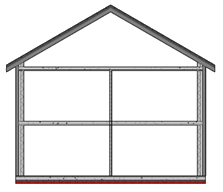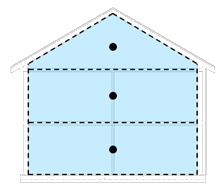In an energy model, spaces are discrete volumes (masses) of air that experience heat loss or gain.
These heat changes are due to internal processes like occupancy, lighting, equipment, and HVAC, as well as heat exchange with other spaces and with the exterior environment. The role of spaces is to capture the variation of interior and exterior heat exchanges accurately throughout a building.
You can think of spaces as similar to rooms in a building. There is often a direct correlation between rooms and spaces, but it is not always that straightforward. For example, you may need to subdivide large rooms (such as an open plan office or an atrium) so the heat transfer processes are represented more accurately. This approach is referred to as thermal zoning, chunking, or blocking. These concepts all relate to the creation of discrete spaces in a building for thermal simulation.
Dividing space by level and room
To understand the creation of discrete spaces in a building, consider the following series of illustrations using a simple theoretical building.
Cross-section of a conceptual building
 |
Assuming this cross-section shows the extents of the building, how many spaces should exist? Consider the following options. |
No discrete spaces
 |
When the building is not divided into discrete spaces, all heat gains and losses are lumped together into a single space. This arrangement does not accurately represent the physical phenomena that occur in the building.
For example, suppose that at some instant in time, there is a large heat loss through a north roof and also a large heat gain through a south wall. This single space is assumed to only experience the net sum of the heat gain and loss. In reality, the localization of the losses and gains may require local heating or cooling. As a result, the simulation results would underestimate the amount of actual heating and cooling required. |
Discrete spaces by level
 |
Suppose that you divide the building space by level.
This approach is an improvement over a single space. It may be adequate in some cases such as the roof space, which may not have heating or cooling. However, this approach still suffers from the same issue: the energy simulation cannot separate simultaneous heat gains and losses sufficiently. |
Discrete spaces by rooms
 |
The most obvious way to organize the sample building into discrete spaces is by rooms.
In the cross-section, the building now looks like it is organized into sufficient spaces for the energy simulation to be able to separate simultaneous heat gains and losses. As a result, it can more reliably determine the energy required to maintain comfort throughout the building. However, some of these rooms may contain large and localized heat gains, like the lighting systems in a theater. In this case, the distribution of heat is not even throughout the space. In these situations, you may want to further break up the space. |
Dividing space by depth and height
Beyond creating discrete spaces by rooms, you can further divide the space by depth, height, or both. These approaches address the reasons for certain energy model authoring practices, such as zoning, blocking, or chunking.
By room and depth (9 spaces)
 |
Creating discrete spaces by depth is a common practice. This approach is useful for conceptual forms when the interior layout, rooms, and zones are not yet defined.
ASHRAE 90.1 Appendix G (LEED) Energy Modeling contains rules on thermal blocking that require the creation of discrete spaces by orientation and perimeter depth. For example, the following floor plan is organized into spaces by depth, according to these ASHRAE guidelines.  To use this approach in Revit, in the Energy Settings dialog, use the Perimeter Zone Division and Perimeter Zone Depth options. |
By room and height (9 spaces)
 |
Creating discrete spaces by height is a less common practice. However, it is useful for simulating tall open rooms like atria, where human occupants are likely to be at the bottom of the space.
This approach can also account for stratification effects from under-floor air distribution systems and for more precise heat gains and losses, as in the theater lighting example. |
Multiple rooms per space
When creating discrete spaces, you can use fewer spaces than rooms. This practice may be called zoning, blocking, or chunking.
You can combine several rooms into one space if they have the same orientation, depth, and function. For example, the following images show a row of small offices on the same elevation of a building. You can use separate spaces for each room (left), or combine the rooms into a single space (right).
| 3 spaces for 3 rooms | 1 space for 3 rooms |
 |
 |
This approach may be computationally efficient. However, it is becoming less important due to the improved automation of space creation, combined with cloud simulation.
Ceiling voids
Use similar considerations for ceiling voids over rooms. Model ceiling voids as discrete spaces when the voids are deep or when they are used as a supply or extract plenum. This decision is part of a detailed HVAC system design.
| Combine a ceiling void with a space. | Use separate a space for a ceiling void. |
 |
 |
Vertical voids
You can use several different approaches to account for vertical voids in an energy model.
| Combine voids with one space. |
 |
| Use separate spaces for voids. |
 |
| Omit spaces for vertical voids. |
 |
Space area
Space area is the floor area of a space. It relates to the floor area over which internal heat gains and power consumption (due to occupancy, lighting, and equipment) occur.

Because those processes are often specified per unit of floor area, the accuracy of space area is important, particularly at early design stages. However space area is also relative, especially when you consider the numerous other associated assumptions (like operating schedules) that dictate actual energy end use.
Space volume
If a space is a discrete mass of air that experiences heat loss or gain, then space volume represents the quantity of air in that space.

The space volume is typically described as the shape of the air. However, the energy simulation engine does not consider its actual shape. Instead, the space volume is simply some discrete mass of air.
Due to the low density and specific heat capacity of air, an energy simulation is not usually sensitive to space volume. Consequently, you do not need to define space volume very accurately to get valid energy analysis results.